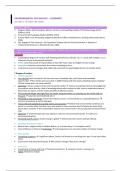Samenvatting
Extensive summary + lectures - Environmental Psychology (6464EL34Y_2324_S1)
This document includes an extensive summary of all articles from the course/elective Environmental Psychology. Besides, it also includes all the information from the lecture slides and notes.
[Meer zien]




